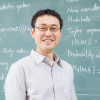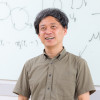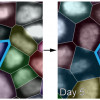Seminar
757 events
-
Seminar
Generalized Erdös and Obláth theorem for polynomial-factorial Diophantine equations
October 23 (Tue) at 10:30 - 11:30, 2018
Wataru Takeda (Nagoya University)
Diophantine equations are equations where only integer solutions are accepted. There are many types of Diophantine equations and many results are known. Our Diophantine equation is of the form x^n+y^n=m!. Erdös and Obláth showed that the Diophantine equation x^2+y^2=m! has only two positive integer solutions (x,y,m)=(1,1,2),(12,24,6). In this talk, the factorial function m! is replaced with a generalized factorial function Π(m) over number fields. Then whether there are infinitely many solutions or not depends on the number field. We give necessary and sufficient condition for existence of infinitely many solutions of x^2+y^2=Π(m). More generally, we introduce an observation for higher degree equation x^n+y^n=Π(m).
Venue: Large Meeting Room, 2F Welfare and Conference Building (Cafeteria)
Event Official Language: English
-
Seminar
Non-Hermitian phase transition from a polariton Bose-Einstein condensate to a photon laser
September 28 (Fri) at 13:30 - 17:00, 2018
Ryo Hanai (Osaka University)
Venue: Seminar Room #160
Event Official Language: Japanese
-
Seminar
Number Theory Seminar: 3 Talks
July 24 (Tue) at 10:00 - 12:35, 2018
Masataka Ono (Keio University)
Shingo Sugiyama (Nihon University)
Yoshinosuke Hirakawa (Keio University)This seminar is aimed at scientists in general, not only to mathematicians. 10:00-10:45 Title: Multiple zeta functions associated with 2-colored rooted trees Speaker: Dr. Masataka Ono (Keio University) Abstract: In our recent work, we introduced a combinatorial object and finite sum associated with them which we call finite multiple zeta values associated with 2-colored rooted trees and gave a unified interpretation to some types of finite multiple zeta values. In this talk, we introduce multiple zeta function associated with 2-colored rooted tree and discuss its analytic properties, for example, the possible singularities and functional equations. 10:55-11:40 Title: Modular forms and trace formulas with applications to equidistributions of their Fourier coefficients Speaker: Dr. Shingo Sugiyama (Nihon University) Abstract: Modular forms are interesting objects in number theory as they are related to arithmetic problems. Trace formulas of Hecke operators acting on modular forms are very useful tools to study arithmetic invariants: Fourier coefficients, special values of L-functions, Hurwitz class numbers. We will start fundamental notions on modular forms and trace formulas of Hecke operators for non-experts, and introduce our results on a generalization of Serre’s vertical Sato-Tate law. Some results in this talk are based on a joint work with Masao Tsuzuki (Sophia University). 11:50-12:35 Title: On a generalization of Dobinski's formula Speaker: Yoshinosuke Hirakawa (Keio University) Abstract: Dobinski's formula is a very classical formula, which expresses the Bell number as an infinite series. Here, the Bell number is the number of partitions of a finite set. Such a "combinatorial-analytic" formula should lead us to more beautiful number theory. In this talk, we introduce a generalization of Dobinski's formula by means of a certain multiple generalization of the exponential function.
Venue: Seminar Room #160
Event Official Language: English
-
Seminar

Introduction to topological band structure
July 6 (Fri) at 10:30 - 17:30, 2018
Tomoki Ozawa (Senior Research Scientist, RIKEN Interdisciplinary Theoretical and Mathematical Sciences Program (iTHEMS))
In this seminar, I give an introduction to topological band structures. Topological band structure is the fundamental idea to understand phenomena such as the quantum Hall effect, topological insulators, and topological superconductors. Although originally found in fermionic electron systems, topological band structure is essentially a single-particle property, and thus the same phenomenon can arise also in bosonic systems. In fact, topological band structure does not even need quantum mechanics; topological band structure can arise in classical waves inside a periodic medium, such as electromagnetic waves or classical mechanical waves. In this seminar, I first give a brief introduction to key concepts in topological band structures, such as Berry curvature, Chern number, bulk-edge correspondence, and ten-fold way classification of topological insulators. I then explain how topological band structure can arise in classical systems, giving a brief introduction to the field of topological photonics and topological mechanics.
Venue: Seminar Room #160
Event Official Language: Japanese
-
Seminar

Topological Photonics and the four-dimensional quantum Hall effect
July 3 (Tue) at 15:00 - 17:00, 2018
Tomoki Ozawa (Senior Research Scientist, RIKEN Interdisciplinary Theoretical and Mathematical Sciences Program (iTHEMS))
In this seminar, I will give an introduction to topological photonics, that is, the study of topological band structures and resulting topological phenomena in photonic systems. I will first review basic concepts of topological band structures, and then explain what it means to realize topological band structures in photonic systems. I will particularly emphasize some important differences with respect to solid-state electron systems. I then present some of my own works in topological photonics, such as the synthetic dimensions in photonic systems, which allows one to explore models and phenomena in high dimensions including the four-dimensional quantum Hall effect.
Venue: 1F Meeting Room, AIMR Main Building
Event Official Language: English
-
Seminar
Denso IT Lab. and RIKEN Joint Innovation Seminar
June 29 (Fri) at 16:00 - 17:40, 2018
16:00-17:00 Denso IT Laboratory "About Denso IT lab." H. Iwasaki (Denso) "Human-Car interface" H. Tsukahara (Denso) "Math in machine leaning and computer vision" K. Ishikawa (Denso) 17:00-17:40 RIKEN "Math bridging between classical and quantum physics: quantum hall effect in classical system" T. Ozawa (RIKEN) "Di-Omega: a new particle predicted by K-computer with mathematical science" S. Gongyo (RIKEN)
Venue: Common Room #246-248
Event Official Language: Japanese
-
Seminar
Introduction to spin-boson model
June 22 (Fri) at 10:30 - 17:30, 2018
Takeo Kato (The Institute for Solid State Physics (ISSP), The University of Tokyo)
10:30-12:30 Introduction to spin-boson model @DR3 (14th Building 213) 14:00-15:30 Kondo effect @DR7 (14th Building 217) 16:00-17:30 Detail of NIBA formalism @DR7 (14th Building 217)
Venue: Yagami Campus, Keio University
Event Official Language: Japanese
-
Seminar

Relative and equivariant Lagrangian Floer homology and Atiyah-Floer conjecture
June 19 (Tue) at 14:30 - 16:00, 2018
Kenji Fukaya (Senior Visiting Scientist, RIKEN Interdisciplinary Theoretical and Mathematical Sciences Program (iTHEMS) / Permanent Member, Simons Center for Geometry and Physics, Stony Brook University, New York, USA)
Atiyah-Floer conjecture concerns a relationship between Floer homology in Gauge theory and Lagrangian Floer homology. One of its difficulty is that the symplectic manifold on which we consider Lagrangian Floer homology is in general singular. In this talk I will explain that, by using relative and equivariant version of Lagrangian Floer homology, we can resolve this problem and can at least state the conjecture as rigorous mathematical conjecture. Supported by RIKEN iTHEMS and Tuesday Seminar on Topology (Graduate School of Mathematical Sciences, The University of Tokyo).
Venue: Room 056, Graduate School of Mathematical Sciences, The University of Tokyo
Event Official Language: Japanese
-
Seminar
1-form Lieb-Schultz-Mattis theorem and anomaly matching in quantum dimer model
June 8 (Fri) at 13:30 - 17:00, 2018
Yuta Kikuchi (RBRC Researcher, Theory Group, RIKEN BNL Research Center, RIKEN Nishina Center for Accelerator-Based Science (RNC))
The Lieb-Schultz-Mattis theorem dictates that a trivial symmetric insulator in lattice models is prohibited if lattice translation symmetry and U(1) charge conservation are both preserved. In this talk, we discuss the generalization of the Lieb-Schultz-Mattis theorem to systems with higher-form symmetries, which act on extended objects of dimension n > 0. The prototypical lattice system with higher-form symmetry is the pure abelian lattice gauge theory whose action consists only of the field strength. We first construct the higher-form generalization of the Lieb-Schultz-Mattis theorem with a proof. We then apply it to the U(1) lattice gauge theory description of the quantum dimer model on bipartite lattices. Finally, using the continuum field theory description in the vicinity of the Rokhsar-Kivelson point of the quantum dimer model, we diagnose and compute the mixed ’t Hooft anomaly corresponding to the higher-form Lieb-Schultz-Mattis theorem.
Venue: SUURI-COOL (Kyoto)
Event Official Language: Japanese
-
Seminar
Abelian-Higgs dualities in quantum defect-mediated melting phase transitions
April 27 (Fri) at 14:30 - 17:30, 2018
Aron Beekman (Keio University)
In the study of zero-temperature quantum phase transitions, instead of looking how symmetry is broken, it is often useful to see how symmetry can be restored by the condensation of topological defects. Through a duality mapping, Nambu-Goldstone modes are represented as gauge bosons, mediating long-range interactions between topological defects. When the latter condense, those bosons get as mass via the Anderson-Higgs mechanism, which signals the loss of rigidity and the restoration of symmetry. I will first review the best-studied case: the 2+1D superfluid-insulator transitions where the defects are U(1) vortices. Consecutively several extensions are discussed: going to 3+1D where the defects are not point particles but strings, and quantum elasticity, which studies breaking of spatial translations and rotations.
Venue: Seminar Room #160
Event Official Language: English
-
Seminar
Thermodynamic of a one-dimensional Bose gas at low temperature & superfluidity in neutron-star matter
April 24 (Tue) at 15:30 - 16:30, 2018
Giulia De Rosi (The Institute of Photonic Sciences, Barcelona, Spain)
Ultracold atomic gases and neutron-star matter play a paramount importance in many-body physics, by exhibiting important analogies and differences. One of the most interesting phenomena shared by both systems is provided by superfluidity. In the first part of the talk, I will show that the chemical potential of a one-dimensional (1D) interacting Bose gas exhibits a non-monotonic temperature dependence which is peculiar of superfluids. The effect is a direct consequence of the phononic nature of the excitation spectrum at large wavelengths exhibited by 1D Bose gases. For low temperatures T, I demonstrate that the coefficient in the T2 expansion of the chemical potential is defined by the zero-temperature density dependence of the sound velocity and it has been calculated along the crossover between the Bogoliubov weakly-interacting gas and the Tonks-Girardeau gas of impenetrable bosons. The theoretical predictions along the crossover are confirmed by comparison with the exactly solvable Yang-Yang model in which the finite-temperature equation of state is obtained numerically by solving Bethe-ansatz equations. In the second part of the talk, I will show the results of a study of the superfluid gap in pure neutron matter, associated with the formation of Cooper pairs in the 1S0 channel. The interaction responsible of the onset of superfluidity is an effective interaction coming from a nuclear Hamiltonian strongly constrained by phenomenology and obtained from the correlated basis function (CBF) perturbation theory and the formalism of cluster expansions. The calculations have been carried out using an improved version of the CBF effective interaction, in which three-nucleon forces are taken into account using a microscopic model. Our results show that the superfluid transition occurs at values of densities corresponding to the neutron-star inner crust.
Venue: Seminar Room #160
Event Official Language: English
-
Seminar

Numerical analysis of point vortex dynamics by the method of fundamental solutions
April 17 (Tue) at 16:00 - 17:30, 2018
Koya Sakakibara (Program-Specific Assistant Professor, Graduate School of Science, Kyoto University)
iTHEMS / KUAMS Joint Seminar
Venue: Maskawa Hall, 1F, Maskawa Building for Education and Research
Event Official Language: Japanese
-
Seminar
Including an ocean mixing model in atmospheric data assimilation: a case of Typhoon Soudelor 2015
April 17 (Tue) at 15:00 - 15:30, 2018
Kohei Takatama (Postdoctoral Researcher, Data Assimilation Research Team, RIKEN Center for Computational Science (R-CCS))
Venue: Maskawa Hall, 1F, Maskawa Building for Education and Research
Event Official Language: English
-
Seminar

Resurgence Theory for Non-Perturbative Quantum Analysis
March 28 (Wed) at 13:00 - 15:00, 2018
Tatsuhiro Misumi (Visiting Scientist, RIKEN Interdisciplinary Theoretical and Mathematical Sciences Program (iTHEMS) / Lecturer, Akita University)
Venue: Seminar Room #160
Event Official Language: English
-
Seminar
Introduction to exact WKB analysis
March 27 (Tue) at 10:00 - 12:00, 2018
Kohei Iwaki (Nagoya University)
Venue: Seminar Room #160
Event Official Language: English
-
Seminar
Anomaly matching for spin chains
March 19 (Mon) at 14:00 - 16:00, 2018
Yuya Tanizaki (Special Postdoctoral Researcher, Theory Group, RIKEN Nishina Center for Accelerator-Based Science (RNC))
Venue: Seminar Room #160
Event Official Language: English
-
Seminar
Several identities related to the degenerate Bernoulli polynomials and numbers
February 24 (Sat) at 16:00 - 17:00, 2018
Takao Komatsu (Professor, Wuhan University, China)
In this talk we demonstrate some relations in degenerate Bernoulli polynomials, which may be expressed as a general convolution identity. We also show some properties of hypergeometric degenerate Bernoulli polynomials and numbers.
Venue: Seminar Room #160
Event Official Language: English
-
Seminar
Diophantine Frobenius Problems — counting theory, generating function and zeta functions
February 23 (Fri) at 16:00 - 17:00, 2018
Takao Komatsu (Professor, Wuhan University, China)
When a_1, ...,a_m are relatively prime positive integers, the number of solutions of the linear Diophantine equation a_1 x_1 + … + a_m x_m = b in non-negative integers x_1, ...,x_m, for any integer b, is our concern. We show several formulas to give the largest integer b without solution. Then we discuss the generating function of the number of solutions. Finally, we derive an explicit expression for an inverse power series over the gaps values of numerical semigroups generated by two integers. It implies a set of new identities for the Hurwitz zeta function.
Venue: Seminar Room #160
Event Official Language: English
-
Seminar

Statistical mechanics of tissue homeostasis
January 22 (Mon) at 14:00 - 15:00, 2018
Kyogo Kawaguchi (The University of Tokyo)
Adult tissues undergo rapid turnover as mature cells are continuously lost and new cells arise through cell division. The balance between the gain and loss of cells must be finely orchestrated to maintain tissues, but how this balance is achieved remains largely unknown. Previous works [1] have used universal scaling laws to claim that the fate choice of stem cells (division or differentiation) are made strictly cell-autonomously. However, we recently recorded every stem cell fate choice within the mouse skin epidermal regions over one week and found that, far from being cell-autonomous, stem cell loss by differentiation is compensated by direct neighboring division [2]. In this talk, I will describe a model of tissue homeostasis using a macroscopic nonequilibrium setup, and explain how the coarse-graining of this model will lead to the effective dynamics of the voter model (DP2). I will show how we can use the property of dynamical crossover in the model -from the cell-autonomous regime (critical birth-death model) to the fate-coordinated regime (voter model)- to measure the length and time scales of stem cell coordination. I will then explain the pitfall in two-dimensions of using scaling relations for the clonal fate trace of cells, and present the workaround we used in the data analysis to definitively show the existence of cell-to-cell fate correlation.
Venue: Common Room #246-248
Event Official Language: English
-
Seminar

Compact-star phenomena and equation of state
December 28 (Thu) at 10:30 - 11:30, 2017
Shun Furusawa (Special Postdoctoral Researcher, RIKEN Interdisciplinary Theoretical and Mathematical Sciences Program (iTHEMS))
Venue: SUURI-COOL (Kyoto)
Event Official Language: English
757 events
Events
Categories
series
- iTHEMS Colloquium
- MACS Colloquium
- iTHEMS Seminar
- iTHEMS Math Seminar
- DMWG Seminar
- iTHEMS Biology Seminar
- iTHEMS Theoretical Physics Seminar
- Information Theory SG Seminar
- Quantum Matter Seminar
- ABBL-iTHEMS Joint Astro Seminar
- Math-Phys Seminar
- Quantum Gravity Gatherings
- RIKEN Quantum Seminar
- Quantum Computation SG Seminar
- Asymptotics in Astrophysics SG Seminar
- GW-EOS WG Seminar
- DEEP-IN Seminar
- NEW WG Seminar
- Lab-Theory Standing Talks
- QFT-core Seminar
- STAMP Seminar
- QuCoIn Seminar
- Number Theory Seminar
- Academic-Industrial Innovation Lecture
- Berkeley-iTHEMS Seminar
- iTHEMS-RNC Meson Science Lab. Joint Seminar
- RIKEN Quantum Lecture
- Theory of Operator Algebras
- iTHEMS Intensive Course-Evolution of Cooperation
- Introduction to Public-Key Cryptography
- Knot Theory
- iTHES Theoretical Science Colloquium
- SUURI-COOL Seminar
- iTHES Seminar
